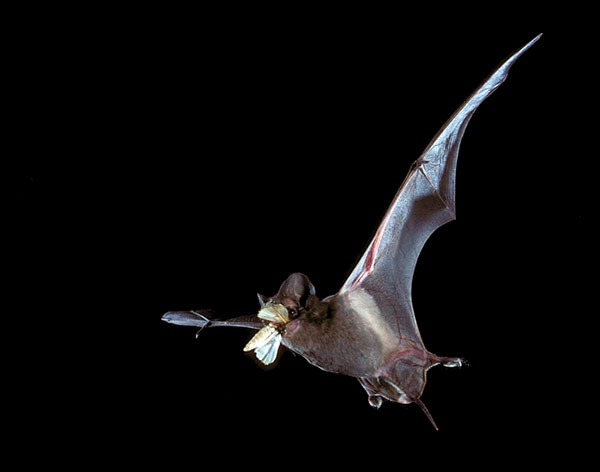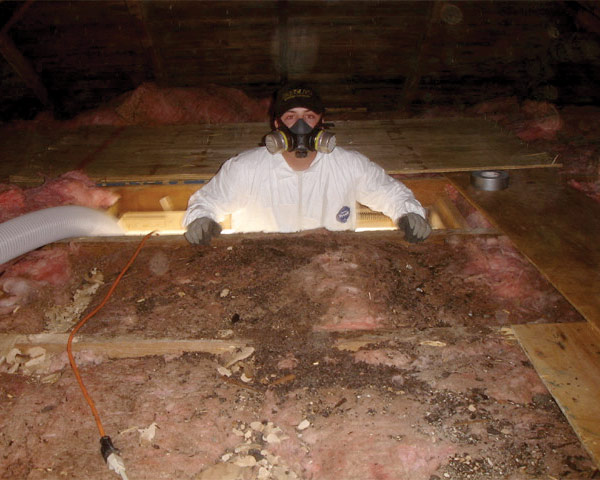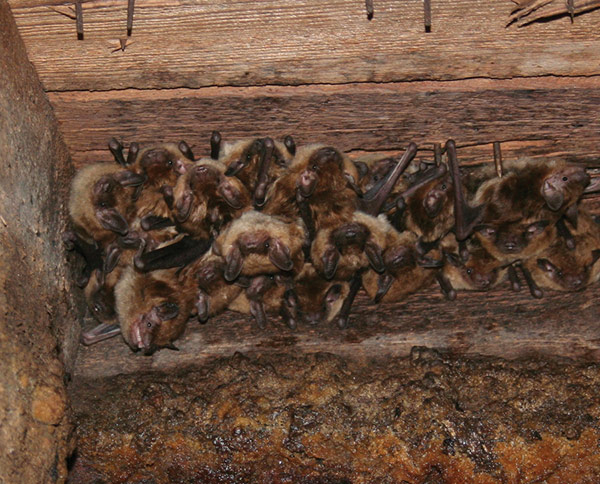Management of Much-Maligned, Often-Misunderstood Bats
 |
|
Bat catching its evening insect meal. Photo: National Park Service. |
By Marcia Anderson, PhD, U.S. EPA
Bats have a reputation for being spooky or even dangerous, but they are some of the most beneficial animals to humankind.
Bats are also some of the most misunderstood and needlessly feared of the world’s creatures. Alas, bats do not encounter people by choice, but only in defense.
Debunking the “Vampire Bat” Stereotype
Very few species of bats are vampire or blood consuming. Of the more than 1,100 species of bats worldwide, only three consume blood, and none live in the United States. Vampire bats live only in tropical climates and typically feed on cattle, poultry, or other livestock.
Most North American bats have small teeth for eating insects and do not gnaw through wood or other building materials.
Vital Ecosystem Services
Bats are essential to maintaining healthy ecosystems and economies, yet their populations are declining worldwide.
Northeastern bats are insectivores, and they need to eat and drink every night. They include many species, such as the big brown, little brown, red, hoary, eastern small-footed myotis, and Indiana bats.
All these bats spend their nights eating pests such as mosquitoes, moths, termites, ants, and cockroaches. A single brown bat can eat 3,000 mosquito-sized insects per night.
Agricultural pests consumed by bats include corn earworms, cucumber beetles, leafhoppers, and stink bugs. Their food requirements are well-served by open fields, parks, spaces near waterways, and agricultural areas.
The University of Connecticut offers a guide to New England bat species that’s helpful for telling them apart: news.extension.uconn.edu/tag/bats/
Bats are essential to maintaining healthy ecosystems and economies, yet their populations are declining worldwide due to loss of roost trees, disturbance of dens, and outright persecution by people.
Some bats are primary pollinators for fruits and other produce and help to disperse seeds of plants vital for natural restoration of forests. Enjoy your bananas, mangoes and guavas—and thank the bats that help to bring these fruits to your table.
Got Bats in Your Belfry, Barn, School, or Attic?
It is illegal for anyone, including animal control officers and exterminators, to kill bats. In many states, it is illegal to disturb nesting bats.
During the day, bats prefer to roost in caves, tight crevices such as cracks in rocks, under exfoliating tree bark, and in barns and awnings of buildings. These locations provide protection from predators and stable temperatures. They also prefer roosting near open bodies of water.
Bats can enter buildings, especially near parks, through openings as small as one-half inch in diameter. Bats may roost in or under attics, soffits, louvers, chimneys, porches, siding, eaves, roof tiles or shingles, and shutters. In stadiums and parking garages, bats sometimes roost in expansion joints between concrete beams.
A solitary bat—often a lost youngster—will occasionally fly into a building through an open door or window. When this happens, the bat’s primary goal is to escape safely back outside.
If bats inhabit your home or an undesirable location, it is important to use proper eviction methods to remove them. It is illegal for anyone, including animal control officers and exterminators, to kill bats. Terminal traps and poisonous bait traps should never be used.
If evicting bats from a building, it is important to provide a nearby shelter, such as a bat house, for the bats to inhabit.
All evictions or exclusions should take place prior to mid-April or after mid-September, as the time in between is bat mating season and, in many states, it is illegal to disturb nesting bats.
 |
|
Sealing bat entry points in a school. Photo: Salt Lake City School District. |
 |
|
Cleaning up bat guano in a home attic requires professionals. Photo: BatGuys.com |
Think You Might Have Bats? Don’t Panic.
The solutions to remove bats from your belfry or other locations are simple. Bats are rarely aggressive, even if they’re being chased.
But be warned, they may bite in self-defense if handled. As with any wild animal, bats should never be touched with bare hands.
Fall Can Be a Batty Time for Schools
Autumn is the time when many North American bat species are beginning their trek back to Mexico and Central America. Because schools may be along the migratory path of bats, they can provide temporary waypoints.
For example, a major bat problem was found in one city’s high school. The building was over 100 years old, and every fall for years, over 3,000 bats would spend time in the halls, classrooms, kitchen, and auditorium.
Bats would enter the school at dawn and exit at dusk from several sites scattered across the building. Every year, the custodians would go to work at 5 a.m. with big nets, running through the school, scooping up the bats, and releasing them outdoors. They would catch as many as they could before the start of the school day.
The Need for an IPM Approach
Then, the school district began implementing an integrated pest management (IPM) program. Facility managers researched how and why bats were entering the building.
As with many pests in schools, exclusion was part of the IPM process that needed to be implemented. An 80-foot lift was used to access and seal openings where bats were entering, such as areas around external pipes. These openings may be around windows, by soffits, or where wires or pipes enter the building.
For the next three years, there was a significant decrease in bats entering the school. Eventually, only one or two bats would find their way into the building when a window was accidentally left open. The good news for the bats was that the school district had the foresight to place bat houses on the school’s roof to give the bats a place to rest, undisturbed, on their long journey south.
As part of the remediation effort, the school district also had to deal with the bat guano (droppings) deposited in the ceiling spaces above the classrooms. There are human health hazards associated with exposure to bat guano, such as histoplasmosis, a serious respiratory disease. Another reason for guano removal is to avoid attracting secondary pests such as cockroaches or flies. A professional hazardous waste company was hired to remove the guano from the school.
After the school district began implementing an IPM program, there was a significant decrease in bats entering the school.
In another part of the country, a Louisiana school found hundreds of bats adjacent to their gymnasium. The bats had found a perfect roost in a void between the gutter and the building that was inaccessible to potential predators. The health department closed the gym because of the risk to students from exposure to bats and their guano.
While guano outside the gym was swept up daily, some still fell inside the gym wall void. School facility staff applied an enzymatic cleaner into the walls to neutralize any pathogens in the guano.
To exclude the bats, the school removed the gutter, installed flashing over the entry space, and put up a new gutter.
Luckily, all the bats successfully relocated. This bat incident cost the school district over $250,000.
 |
|
Little brown bats harboring in an old Delaware church. Photo: National Park Service. |
 |
|
Building a bat house. Photo: University of Connecticut Natural Resource Conservation Academy |
Identifying Bats and Helping Them Find a New Home
If you have bat issues, do some bat detective work prior to acting.
To start, identify the bat species involved—there may be more than one sharing a roost. Some bats are federally protected, so it is important to comply with their protection laws.
Identification can also help if the community or school district is considering building alternative housing for the bats. Bat houses can offer bats enticing dwellings not occupied by humans.
Each bat house should be appropriate for the species, large enough to hold several bats, and placed away from buildings when possible.
Note that not all commercially available bat houses are suitable for North American species, so be diligent when shopping.
Some high school shops and university conservation groups have incorporated bat house construction into their curriculum.
For best results, install your bat houses a few weeks prior to an exclusion effort to allow the bats time to find their new homes.
Resources
For best results, install bat houses a few weeks prior to an exclusion effort to allow the bats time to find their new homes.
For more information on bat exclusion and bat house construction, visit Bat Conservation International (www.batcon.org) and Free Woodworking Plans (free.woodworking-plans.org/bat-house-plans.html).
